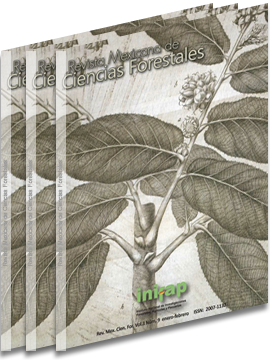ANALYSIS OF PIGMENTS, PEROXIDASE, PROLINE AND PROTEINS OF THREE Paulownia SPECIES UNDER WATER STRESS
DOI:
https://doi.org/10.29298/rmcf.v3i9.532Keywords:
Amino acids, luthein, Paulownia elongata S. Y. Hu, Paulownia fortunei (Seem.) Hemsl., Paulownia imperialis Siebold & Zucc., peroxidase, violaxantinAbstract
Paulownia trees are fast growing and are economically important in Asia as raw material regularly used for furniture, musical instruments, fences, etc., which rose some interest in their cultivation in different environments. In order to assess water stress tolerance, three of these species, P. imperialis, P. fortunei and P. elongate, were selected as they are the most commonly used in reforestation and wood industry in China. Biochemical analyses were performed in leaves, to determine the following elements: pigments (total, a and b chlorophyll; β-carotene, violaxanthin; lutein), peroxidase, proline, total, soluble and insoluble proteins, under three moisture soil concentrations and two environments, field and greenhouse, the latter of which revealed significant differences between them; there is an increment in pigment and peroxidase content and a decrease in protein and proline content, mainly in the greenhouse environment. When water stress was assessed among species, it was concluded that P. imperialis and P. elongata are more tolerant than P. fortunei because of their higher content of proline, total and soluble proteins, which are major tolerance markers in stress conditions.
Downloads
Downloads
Published
How to Cite
Issue
Section
License
The authors who publish in Revista Mexicana de Ciencias Forestales accept the following conditions:
In accordance with copyright laws, Revista Mexicana de Ciencias Forestales recognizes and respects the authors’ moral right and ownership of property rights which will be transferred to the journal for dissemination in open access.
All the texts published by Revista Mexicana de Ciencias Forestales –with no exception– are distributed under a Creative Commons License Attribution-NonCommercial 4.0 International (CC BY-NC 4.0), which allows third parties to use the publication as long as the work’s authorship and its first publication in this journal are mentioned
The author(s) can enter into independent and additional contractual agreements for the nonexclusive distribution of the version of the article published in Revista Mexicana de Ciencias Forestales (for example, include it into an institutional repository or publish it in a book) as long as it is clearly and explicitly indicated that the work was published for the first time in Revista Mexicana de Ciencias Forestales.
For all the above, the authors shall send the form of Letter-transfer of Property Rights for the first publication duly filled in and signed by the author(s). This form must be sent as a PDF file to: ciencia.forestal2@inifap.gob.mx
This work is licensed under a Creative Commons Attribution-Noncommercial 4.0 International license.







